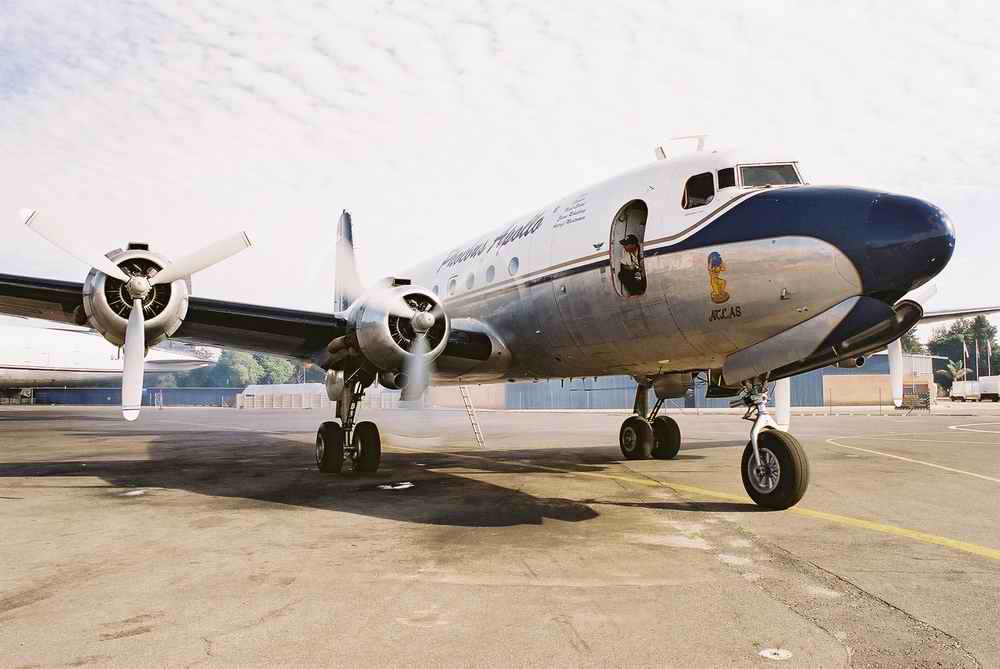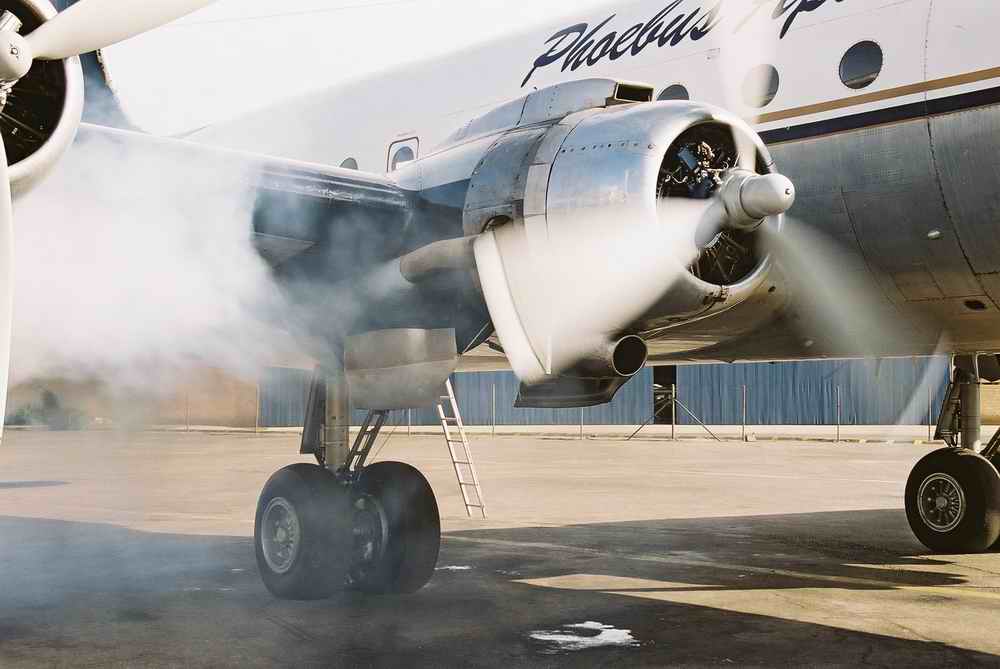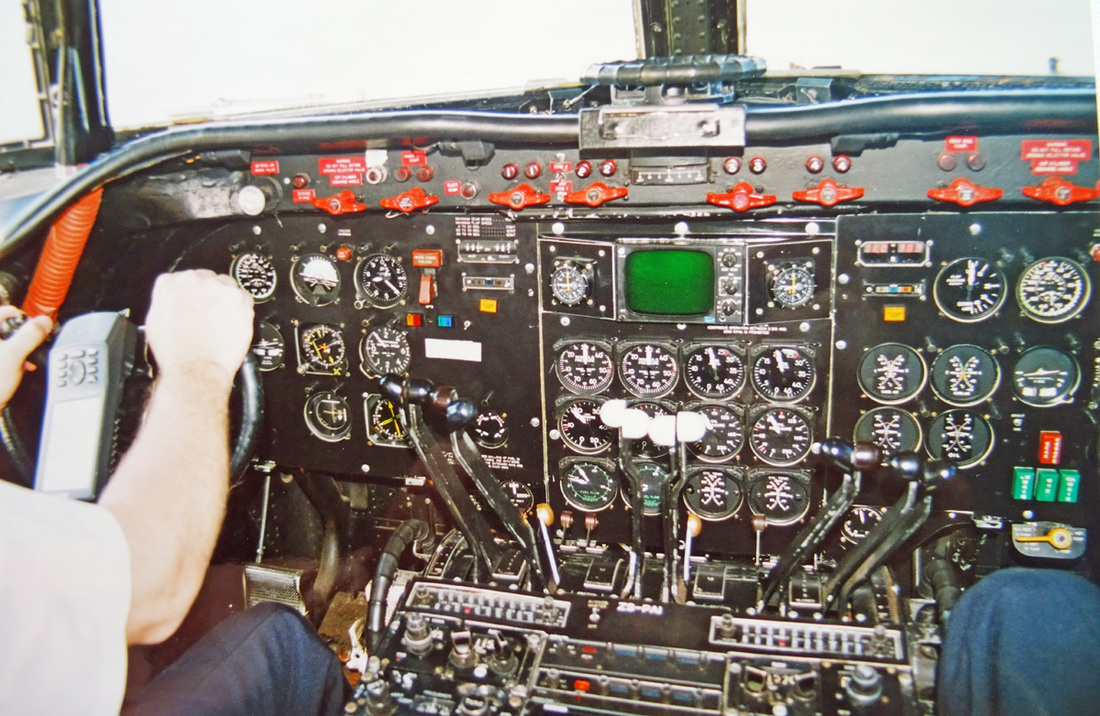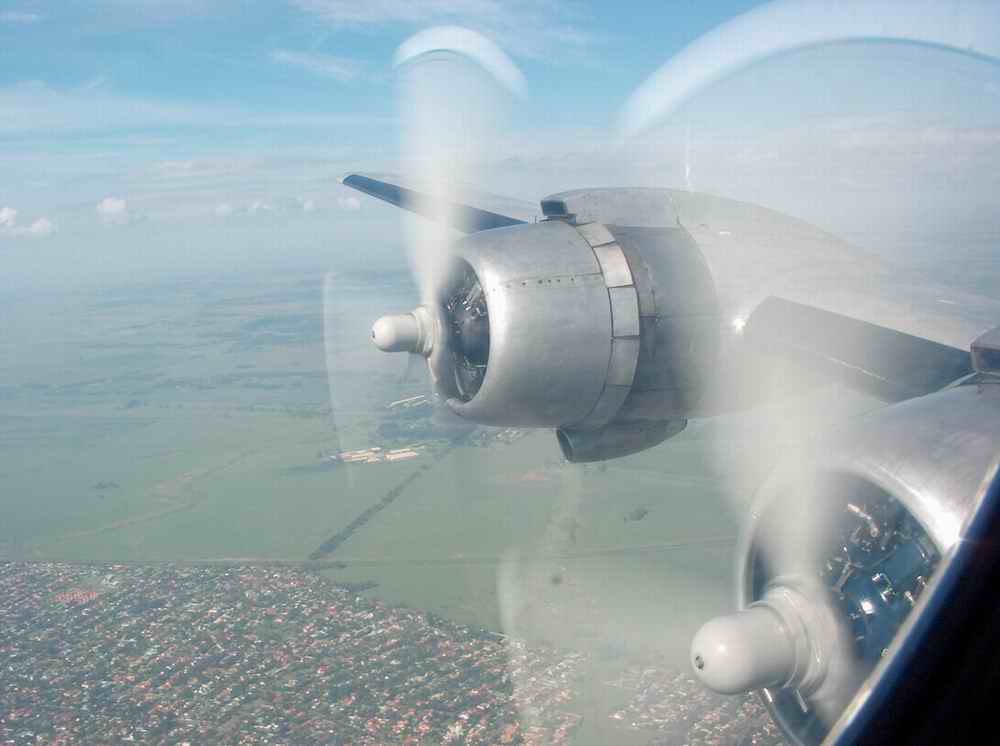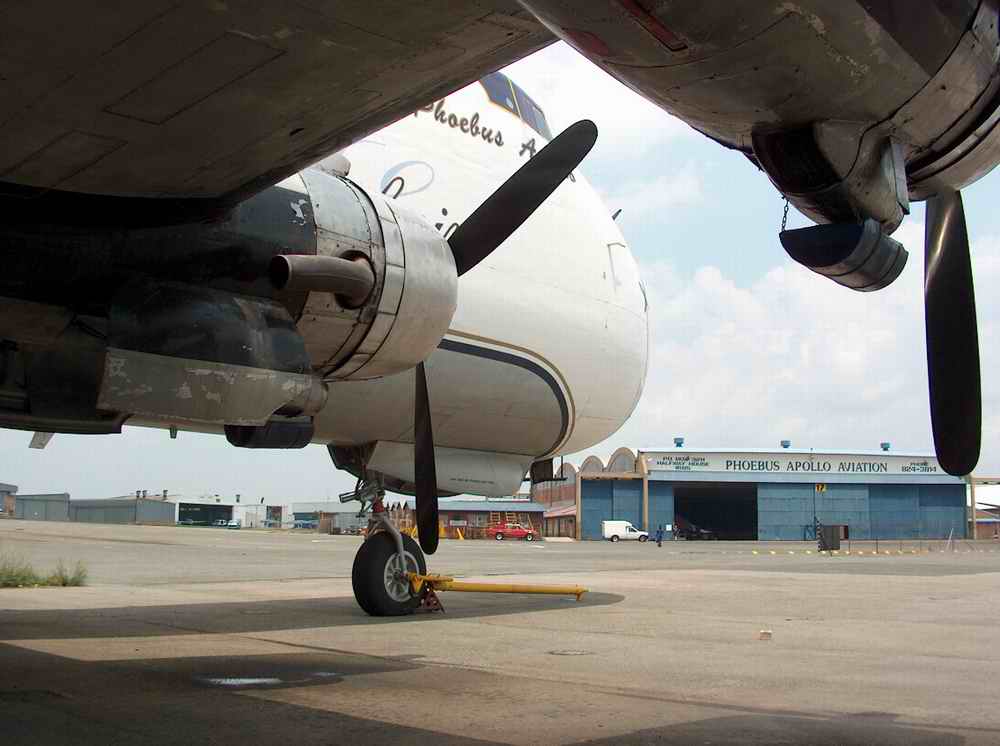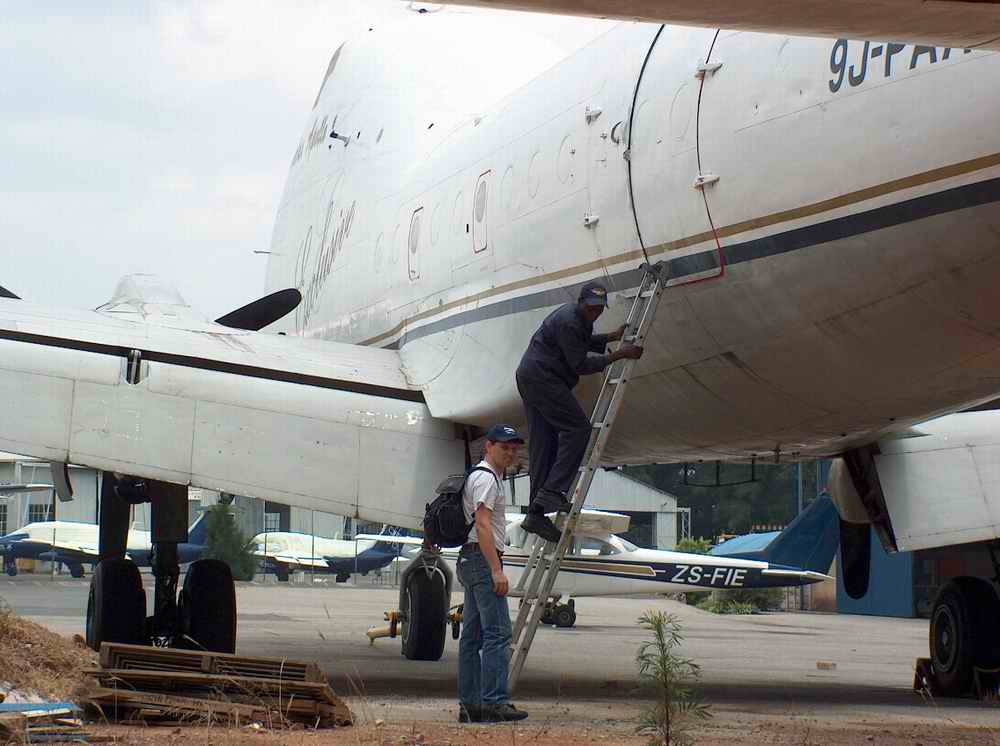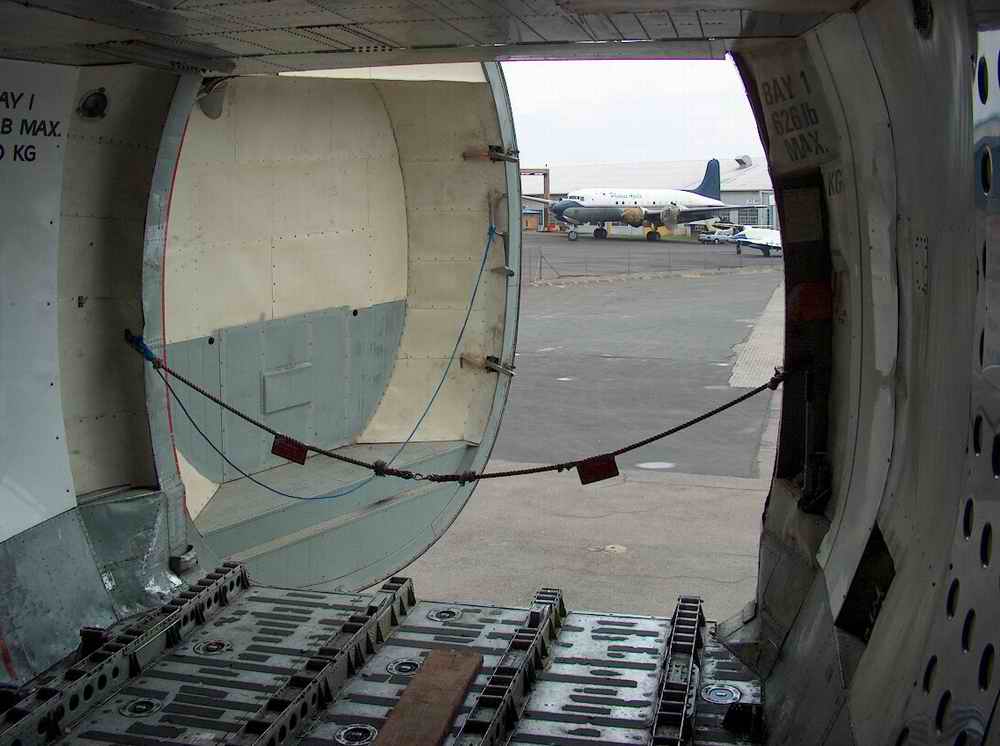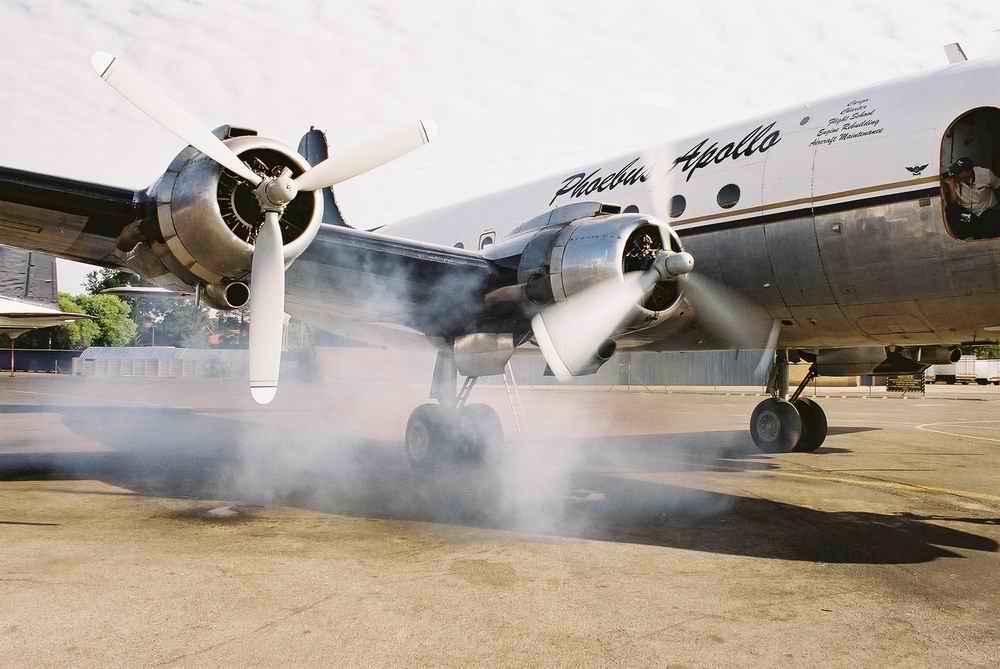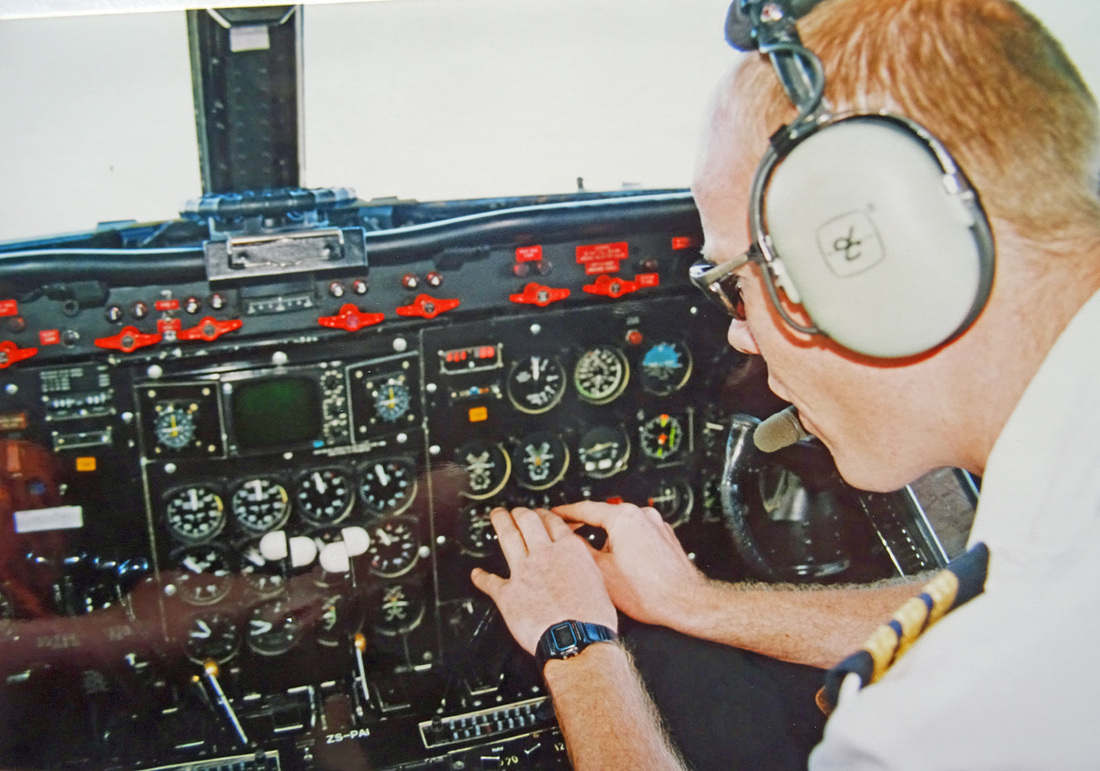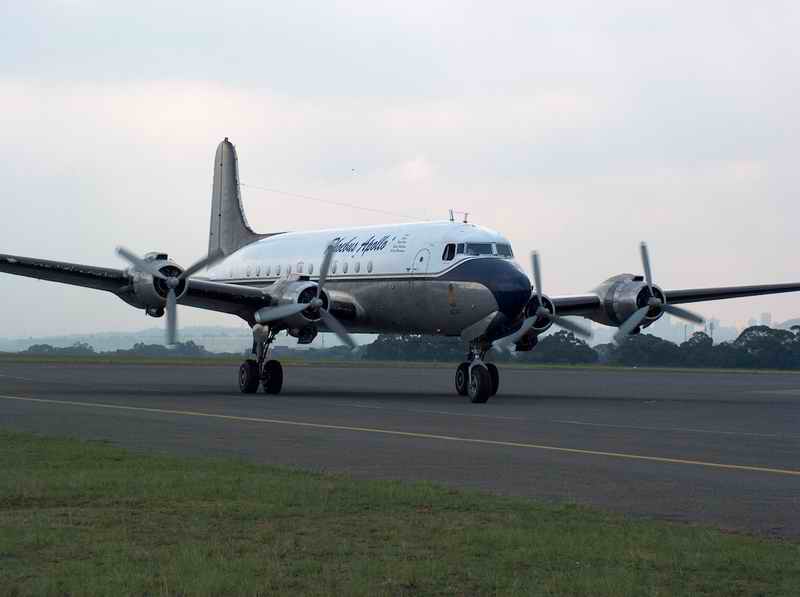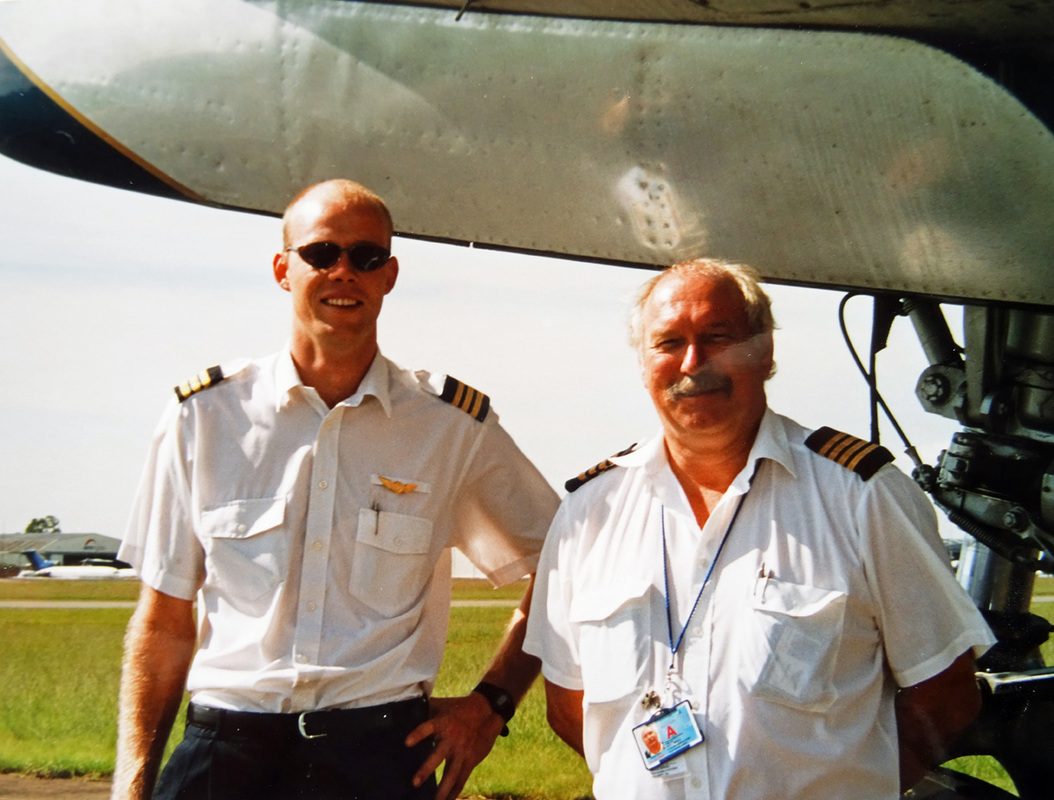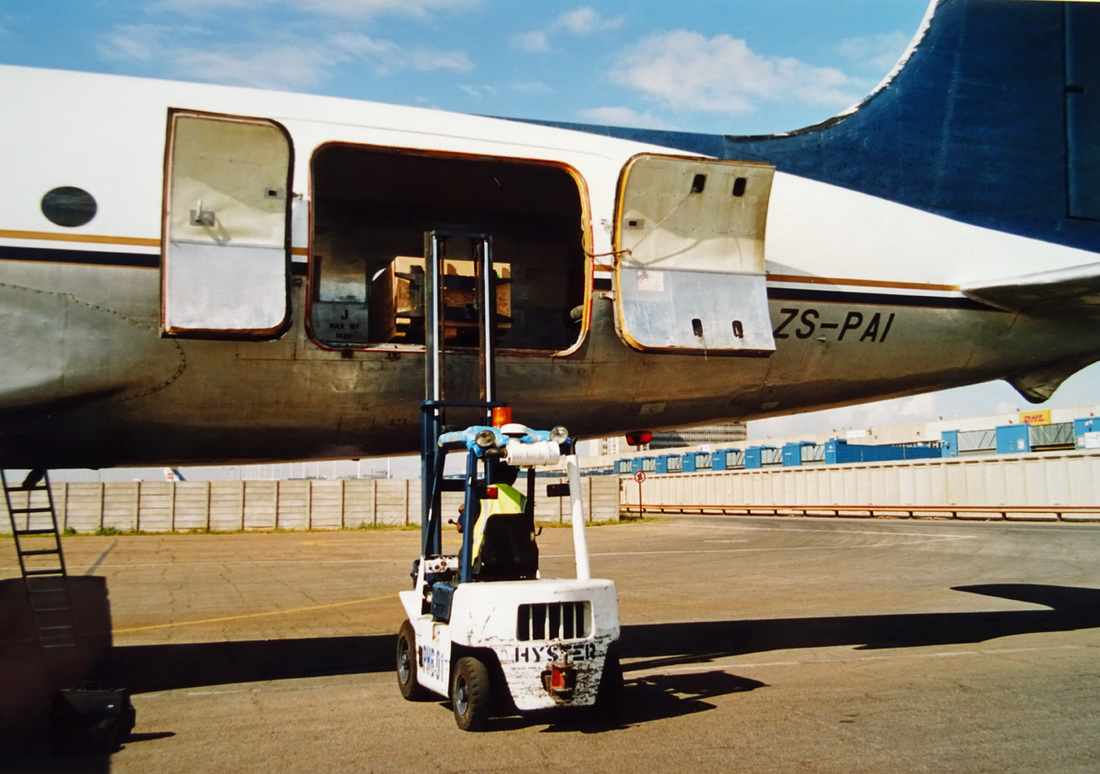INBOUND JAN SMUTS
Enjoy a DC-4 positioning flight from Jo’burg-Rand Airport
“Being know to all men that I, Phoebus Apollo, being Monarch of the Sky, I’m Lord of all things that fly. Be it further known that I, Phoebus Apollo, being the Sun God, I’m also Protector of all those individuals that fly alone in the Sky” -.
By Jan Koppen
Photo’s Courtesy by Micheal Prophet
|
Several years ago I had an opportunity to lay my hands on a detailed DC-4 operating manual and after studying the manual thoroughly, I hoped to observe and discuss the flight characteristics of such a big, round-engine transport one time. Phoebus Apollo of Johannesburg, Rand Airport, who operates two DC-4s and one Carvair, gave me the change to jumpseat on one of their freighters to sample some real life DC-4 action.
In South-Africa , turbinepowered aircraft and jets dominate the transportation scene. Fleets of Hawker Siddeley 748s, Boeing 737-200s and 727s are constantly on the move. Fortunately one or two heavy piston freighters still serve as feeders for the major scheduled airlines. Among the “heavies” is the Douglas DC-4, still moving awkward, heavy loads into the airports of Harare, Zimbabwe, Lusaka, Zambia and Gabarone, Botswana. Although many propliners were owned by South-African companies and the SAAF, their numbers have dwindled dramaticly. Phoebus Apollo of Johannesburg-Rand Airport Phoebus Apollo of Johannesburg-Rand Airport, has next to a large fleet of light aircraft, two DC-3s, two DC-4s and one Carvair. Phoebus Apollo’s roots lie way back in 1976, when the owner, Mr. Henny Delpoort, first flew solo. Their cargo operation info Africa began in 1988 and passenger flights in 1989. The company has grown rapidly into the substantial operation it is today. Next to the above mentioned, this also includes a flight school and an engine division. The company is doing complete overhaul and testing of Pratt & Whitney R-2000s and R-1830s, being the radials of the DC-4 and DC-3 respectively. Phoebus Apollo is also heavily involved in “the Nostalgia of Air Travels, - the way it used to be. When there was no piped music, but gin and tonic was cold, and the roar of the propellers was comforting. When Zimbabwe was Southern Rhodesia, Maputo was still Lourenco Marques, and finally your Boeing 747 was a Dakota !”. Phoebus Apollo purchased their DC-3 and DC-4 freighters in the second half of 1990s from an US broker. The Carvair was bought in March 2002 and the airplanes are based at Jo’burg-Rand airport, which is situated on the south-east side of Johannesburg City. Assigned registration are ZS-PAI, ZS-PAJ for the DC-4s and ZS-PAA for the Carvair. Some months ago this versitale freighter was reregistrated as 9J-PAA and is up for sale for $ 250.000,-. Last couple of month’s the Carvair has not flown much. The bulbous leviathan has a slightly lower airspeed then the slender DC-4s and consumes about 10% more Aviation-gas. This could be the reason for the wish to dipose her. Phoebus Apollo use the DC-3 and DC-4 freighters strictly for scheduled freight service and cargo charters to its neightbouring countries. Despite rising fuel and insurance costs, round-piston-engined freighters are still economically competitive. The DC-4 uses a gallon a mile. Ofcourse, aircraft such as the Lockheed Hercules, can take twice as much as a DC-4, but it’s twice as expensive. Since 1988 , Phoebus Apollo is flying ZS-PAI, ZS-PAJ and 9J-PAA on freight-flights from Johannesburg International, as the impressive facility at Rand is used as headquarters and for maintenance only. During 1998 and 2003 the DC-4s were always out and running around the clock. Bulk items such as 12,000 pound generators and even complete light aircraft fuselage’s were airlifted. Sadly last year the company encountered some bureaucratic difficulties and work is presently a bit slow. ZS-PAI started its career as Factory Number 27319, and was delivered to the USAAF on 13 April 1945. Eventually, she was stored at Davis Monthan Air Force base in February 1973. Rescue from this bone-yard came from Aero Union Corperation in August 1978 and she got the civil registration N4989K. She changed hands quite often in the eighties and in 1994 she was sold to IFL/Air Cargo Contractors of Detroit- Pontiac Airport, Mitchigan. They intensively used the freighter for charterwork in the automotive industry. In 1998 she was finally sold to Phoebus Apollo. ZS-PAJ also started her career in 1945 with the USAAF. In October 1954 she was sold to the 721 Sqn. of the Danish Air Force as N-242. The aircraft was, via a broker, returned to North America and sold to Canadian Millardair. They did not operate the bird but placed her in storage at Davis Monthan in December 1978. In 1991 she also crossed the North-Atlantic ocean for a new career in Africa, with InterOcean Airways as C9-ATS. Later she was reregistrated as EL-AWX. In January 2000 she was added to the Phoebus Apollo fleet. Presently ‘PAJ’ is in maintenance at Phoebus Apollo’s facility at Rand Airport and it is expected to have her back in the air soon. Carvair 9J-PAA started as a C-54E-5-DO for the USAAF in April ’45, but was reconfigurated to a DC-4 by the Douglas company few month’s after the 2nd World-War. Registrated N88881 for Pan American World Airways, it served on transcontinental and transoceanic runs when four engine propeller airliners were at their zenith. The Pan American Clipper was sold to Japan Airlines in February 1958 as JA6015. Seven years later she was sold to Ansett-ANA of Australia. Replaced in the jet age, c/n 27314 became a candidate for Carvair conversion by Aviation Traders in Southend-on-Sea, U.K., in the summer of 1968. Already in 1974 she changed hands again. Being importated to New Zealand as ZK-NWB she flew cargo for Nationwide Air. In March 1996, the now old bird, had to cross the Pacific Ocean as she was sold to Hawaii Pacific Air as N5459M. Here she operated inter-island cargo service, before she was stored for a some time at Honolulu Airport. In 1996 she was finally made operational by WonderAir of Pretoria, South-Africa and the plane arrived on South-African soil in July that year. After been stored some time at Pretoria-Wonderboom Airport she was bought by Phoebus Apollo in March 2002. An early morning positioning-flight to Johannesburg Int’l. It was from a small waiting room several month’s ago at Phoebus Apollo that I first saw the round, slender bodies of the two DC-4s and the fatso Carvair, as several groundmechanics tented to their maintenance needs. As a guest of the company my good friend Mr. Micheal S. Prophet and I would accompany ZS-PAI on an early morning positioning-flight to Johannesburg - Jan Smuts International Airport, which is situated only a couple of miles northeast of Rand Airport. When walking up to ‘PAI’, I understood how anyone could mesmerized by the size. The wings, to which four Pratt & Whitney R-2000s were attached, extended 117 feet, 6 inches from tip to tip. The huge 13 foot, 1 inch Hamilton Standard propellors were many feet from the oil stained tarmac. Nose to tail, the length was 93 feet, 11 inches and the rudder towered above some of the nearby historical hangars of Rand Airport. Keep in mind Rand was already established before the 2nd World-War and its main terminal building was build in the shape of a Junker 52, which South African Airlines operated during these days. Captain Tony Baxter and First Officer Laurie Mey made up the crew. Baxter and Mey had earned their way to their respective seats by “driving” long hard hours flying everything from underpowerd Cessna 172s to cargo-laden coughing DC-3s. At departure time At departure time, ‘PAI’ was light on fuel and devoid of any cargo. F/O Mey checked each of the large tires to ensure the brakes were OK. With fuel and oil verified, we boarded ‘PAI’ by a precarious ladder which was placed against the wide cargo doors aft of the massive left-hand wing. In the cockpit, behind the pilot, were two observerseats and a seperated compartment behind the cockpit held a sleeping bunk and storage bin. The instrument panel was festooned everywhere with switches, levers of red and white lights and included digital ADF, two VHF’s, an ILS head, a horizontal directional gyro and even two GPS’s. Once brilliant red paint on the emergency panels had faded into dull splotched blotches. Greasy handprints showed around the windowframes. Behind the flight deck, was the 55 foot, 5 inch cargo compartment. Ofcourse she looked a bit worn in a few places, but judging by the snag-free maintenance log, ‘PAI’ is a well cared bird. Complicated airplanes like the DC-4 require detailed flight manuals. With the crew’s permission, I perused the voluminous tome of ‘PAI’ to learn that at the time of our flight, total airframe hours was a grand total of 28,800. Douglas ‘PAI’, a heavy at 41,405 pounds empty weight, was topped with 120 US gallons each main tank of volatile 100LL. “Fuel consumption’s is approximately 220 US gallons per hour,” – explained Tony. “With full fuel, we can remain airborne for fourtheen hours.” At 08.15 precisely At 08.15 precisely, “Phoebus Apollo 8004 contacted Rand Ground Control for start-up clearance. This was duly approved, and conscientious prestart banter between the pilots indicated the DC-4 would soon be coming to life. Bells rang in test, gear horns blared and hands flew to switches and throttles and back again. Soon – an APU (auxiliary power unit) sounding much like a lawn mower reverberated from somewhere. Tony planned to start number three engine first. To the tune of “Turning! 3! 6! 9! Switches!” the blades paddled by, the engine shook, belched blue smoke and soon settled into a rumbling deep bass. Numbers 4, 1 and 2 were then started in succession. Engine treatment of the R-2000 radial engines is a very important aspect in order to extend their lifecycle. Oil pressure must rise above minimums within 30 seconds, otherwise the offending powerplant would be destroyed. At least a 800-1000 rpm idle should be maintained to prevent fouled plugs. Run-ups are carried out at 1500 rpm, with a maximum drop of 100 rpm. With taxy clearance received, we powered our way towards the holding point for runway 29. During our lenghtly taxy we passed many of Rand’s historical hangars and classic aircraft, such as Tiger Moth’s, Harvards, a Piago’s 166 , a PBY-5A Catalina, Spingbok Safaris DC3 and DC4, both former Transair Cargo DC-6s, a lone DC-3 and even a SudAvion Caravelle-11R. Rudder pedals are not used at slow taxi. Instead, a small circular steering wheel beneath the left front windshield panel is used. Ordered by Air Traffic Control to hold in position at the holding point of 29 the crew waited for an incoming Harvard of Rand’s flying club. Tony and Laurie, held the aircraft against the brakes, knowing propellers can exercise much of their thrust at even zero forward speed. Finally, after clearance received, Tony lined ‘PAI’ up over 06 ‘piano keys’ . As soon as the aircraft was correctly aligned with the runway centreline, the brakes were applied and the throttles were eased forward to 47 inches manifold pressure and 2700 rpm. On release, the ‘old bird’ rocked and shaked violently. We surged forward and gathered speed as we raced along the runway. At 50 mph with 15° flap setting, the rudder became effective and the combined power of the engines ripped the sprightly airplane off the strip in 19 seconds . Tony held her, once off the surface and wheels in the wells, at 140 KIAS with 500 fpm, in a smooth steady climb towards a scattered cloud layer. On the right-hand Johannesburg’s skyline passed-by. A gentle left turn on to a heading of 210 degrees and clearance to climb to 8,000 feet followed. During the journey upward, Tony and Laurie constanly monitored the engine gauges, making fine adjustment to the throttle settings in order to keep each engine at the correct power setting. When the airplane leveled at 8000, average indicated cruise speed increased to 170 knots, with power settings of 28 inches manifold pressure and 2050 rpm. We next contacted Johannesburg Approach and their controller gave a series of heading changes which set us up to intersept the ILS for runway 03R. Descent speed with no flap and gear up averaged 180 knots. Soon airspeed dropped to 176 knots, so 20° flap could be used. Gear speed was 156 knots and the Skymaster’s wheels thumped firmly downwards. Then at 137 knots, flap went to 30° and by watching over the shoulders of the crew, I could see we passed overhead several town-ships before Jo’burg tower was contacted. Tony flew the downwind leg at 125 knots and base at 120 knots. Five miles from touchdown, we received landing clearance together with the wind of 240 degrees at five knots. With the Douglas neatly following the glideslope, final checks were carried out, undercarriage and flaps selected, and we settled back in our seats. We watched as Tony grappled with the aircraft as he manually flew the ILS to short finals. We crossed the perimeter fence exactly on the centreline and glideslope, and made gentle contact with the runway. With light brake application the four engine freighter stopped in less than a fifth of the 11,155 feet long runway and as we trundled to the remote situated ‘Whiskey’ apron, it appeared that ‘PAI’ was the only piston-powered aircraft in sight. As the huge flatbladed propellers wound down an almost eerie silence pervaded the interior of the freighter. Laurie opened the wide cargo doors and attached a precarious ladder. Our airline representative and ground crew were on hand to meet the aircraft, and within half-an-hour a fresh consignment of cargo was being loaded, and the her fueltanks were resplenished as needed. At 11.55 local time, ZS-PAI , using the callsign “Phoebus 8004”, smoked her way out of Jo’burg on a northbound trip to respectively Harare, Zimbabwe and Lusaka, Zambia. We left Johannesburg that evening in less exciting fashion, aboard a regular scheduled Boeing 747 flight to Amsterdam. Reflections We reflected that night what a great day it had been and how lucky we had been to be able to fly such historic airliner and I hope that round engined classics, like ‘PAI’, will continue to produce wholesome revenue for Phoebus Apollo and outweight the advantages of owning a prestigious DC-9 freighter-jet. *** Die skiijwer wil graag Henny Delpoort,Tony Baxter, Johan Scholtz en Laurie Mey bedank vir hulle vriendelikheid, behulpsaamheid en bijstand, wat die samenstelling van hierdie artikel moonhik gemaak het (The author would like to thank the Phoebus Apollo team for their kind assistance). |
|








